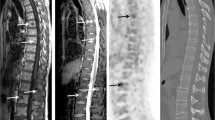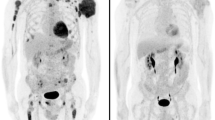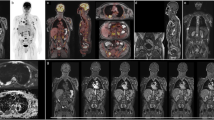Abstract
Objective
To determine the diagnostic accuracy of WB-MRI and 18F-FDG PET/CT in detecting infiltration pattern, disease activity, and response to treatment in patients with multiple myeloma (MM).
Materials and methods
Fifty-six patients with confirmed MM were included in the present study for pre-treatment evaluation. Among these individuals, 22 patients were available for the post-treatment evaluation of response to therapy. All patients were imaged with both WB-MRI and 18F-FDG PET/CT. All radiographic findings of infiltration pattern, disease activity, and response to therapy were compared. The diagnostic performance of both modalities was estimated using bone marrow aspirate and biopsy as the reference test.
Results
For detection of active myelomatous tissue at diagnosis, WB-MRI achieved higher sensitivity (94%) than 18F-FDG PET/CT (75%) (p = 0.0039), whereas both modalities achieved the same specificity (80%). For detection of residual myelomatous tissue after treatment, 18F-FDG PET/CT achieved higher specificity (86%) than WB-MRI (43%) (p = 0.0081), whereas both modalities achieved the same sensitivity (75%).
Conclusion
WB-MRI is more sensitive than 18F-FDG PET/CT in the diagnosis of MM before treatment; however, 18F-FDG PET/CT is more specific than WB-MRI in detecting residual involvement in treated patients.





Similar content being viewed by others
Abbreviations
- AUC:
-
Area under the curve
- CI:
-
Confidence interval
- 18F-FDG PET/CT:
-
18F-Fluorodeoxyglucose (FDG) positron emission tomography/computed tomography
- IMWG:
-
International Myeloma Working Group
- IMA:
-
Inter-modality agreement
- MIP:
-
Maximum-intensity projection
- MM:
-
Multiple myeloma
- ROC:
-
Receiver-operating characteristic
- SI:
-
Signal intensity
- STIR:
-
Short inversion time inversion recovery
- SUVmax:
-
Maximum standardized uptake value
- WB-MRI:
-
Whole-body magnetic resonance imaging
References
Caers J, Withofs N, Hillengass J, et al. The role of positron emission tomography-computed tomography and magnetic resonance imaging in diagnosis and follow up of multiple myeloma. Haematologica. 2014;99(4):629–37.
Rajkumar SV. Multiple myeloma: 2016 update on diagnosis, risk-stratification, and management. Am J Hematol. 2016;91(7):719–34.
Angtuaco EJ, Fassas AB, Walker R, Sethi R, Barlogie B. Multiple myeloma: clinical review and diagnostic imaging 1. Radiology. 2004;231(1):11–23.
Lütje S, de Rooy JW, Croockewit S, Koedam E, Oyen WJ, Raymakers RA. Role of radiography, MRI and FDG-18F-FDG PET/CT in diagnosing, staging and therapeutical evaluation of patients with multiple myeloma. Ann Hematol. 2009;88(12):1161.
Derlin T, Weber C, Habermann CR, et al. 18F-FDG 18F-FDG PET/CT for detection and localization of residual or recurrent disease in patients with multiple myeloma after stem cell transplantation. Eur J Nucl Med Mol Imaging. 2012;39(3):493–500.
Fonti R, Salvatore B, Quarantelli M, et al. 18F-FDG 18F-FDG PET/CT, 99mTc-MIBI, and MRI in evaluation of patients with multiple myeloma. J Nucl Med. 2008;49(2):195–200.
Rajkumar SV, Harousseau JL, Durie B, et al. Consensus recommendations for the uniform reporting of clinical trials: report of the International Myeloma Workshop Consensus Panel 1. Blood. 2011;117(18):4691–5.
Dimopoulos M, Kyle R, Fermand JP, et al. Consensus recommendations for standard investigative workup: report of the International Myeloma Workshop Consensus Panel 3. Blood. 2011;117(18):4701–5.
Durie BG. The role of anatomic and functional staging in myeloma: description of Durie/Salmon plus staging system. Eur J Cancer. 2006;42(11):1539–43.
Kyle RA, Rajkumar SV. Criteria for diagnosis, staging, risk stratification and response assessment of multiple myeloma. Leukemia. 2014;28(4):980.
Palumbo A, Rajkumar SV. Treatment of newly diagnosed myeloma. Leukemia. 2009;23(3):449–56.
Breyer RJ, Mulligan ME, Smith SE, Line BR, Badros AZ. Comparison of imaging with FDG PET/CT with other imaging modalities in myeloma. Skeletal Radiol. 2006;35(9):632–40.
Shortt CP, Gleeson TG, Breen KA, et al. Whole-body MRI versus PET in assessment of multiple myeloma disease activity. Am J Roentgenol. 2009;192(4):980–6.
Schmidt GP, Kramer H, Reiser MF, Glaser C. Whole-body magnetic resonance imaging and positron emission tomography-computed tomography in oncology. Top Magn Reson Imaging. 2007;18(3):193–202.
Nanni C, Zamagni E, Farsad M, et al. Role of 18F-FDG 18F-FDG PET/CT in the assessment of bone involvement in newly diagnosed multiple myeloma: preliminary results. Eur J Nucl Med Mol Imaging. 2006;33(5):525–31.
Zamagni E, Nanni C, Patriarca F, et al. A prospective comparison of 18F-fluorodeoxyglucose positron emission tomography-computed tomography, magnetic resonance imaging and whole-body planar radiographs in the assessment of bone disease in newly diagnosed multiple myeloma. Haematologica. 2007;92(1):50–5.
Dimopoulos M, Terpos E, Comenzo RL, et al. International myeloma working group consensus statement and guidelines regarding the current role of imaging techniques in the diagnosis and monitoring of multiple Myeloma. Leukemia. 2009;23(9):1545–56.
Cascini GL, Falcone C, Console D, et al. Whole-body MRI and 18F-FDG PET/CT in multiple myeloma patients during staging and after treatment: personal experience in a longitudinal study. Radiol Med (Torino). 2013;118(6):930–48.
Weininger M, Lauterbach B, Knop S, et al. Whole-body MRI of multiple myeloma: comparison of different MRI sequences in assessment of different growth patterns. Eur J Radiol. 2009;69(2):339–45.
Ghanem N, Lohrmann C, Engelhardt M, et al. Whole-body MRI in the detection of bone marrow infiltration in patients with plasma cell neoplasms in comparison to the radiological skeletal survey. Eur Radiol. 2006;16(5):1005–14.
Falcone C, Cipullo S, Sannino P, Restuccia A. Whole body magnetic resonance and CT-PET in patients affected by multiple myeloma during staging before treatment. Recenti Prog Med. 2012;103(11):444–9.
Moulopoulos LA, Gika D, Anagnostopoulos A, et al. Prognostic significance of magnetic resonance imaging of bone marrow in previously untreated patients with multiple myeloma. Ann Oncol. 2005;16(11):1824–8.
Moreau P, Attal M, Caillot D, et al. Prospective evaluation of magnetic resonance imaging and [18F] fluorodeoxyglucose positron emission tomography-computed tomography at diagnosis and before maintenance therapy in symptomatic patients with multiple myeloma included in the IFM/DFCI 2009 trial: results of the IMAJEM study. J Clin Oncol. 2017;35(25):2911–8.
Bredella MA, Steinbach L, Caputo G, Segall G, Hawkins R. Value of FDG PET in the assessment of patients with multiple myeloma. Am J Roentgenol. 2005;184(4):1199–204.
Zamagni E, Patriarca F, Nanni C, et al. Prognostic relevance of 18-F FDG 18F-FDG PET/CT in newly diagnosed multiple myeloma patients treated with up-front autologous transplantation. Blood. 2011;118(23):5989–95.
Moulopoulos LA, Dimopoulos MA, Kastritis E, et al. Diffuse pattern of bone marrow involvement on magnetic resonance imaging is associated with high risk cytogenetics and poor outcome in newly diagnosed, symptomatic patients with multiple myeloma: a single center experience on 228 patients. Am J Hematol. 2012;87(9):861–4.
Filonzi G, Mancuso K, Zamagni E, et al. A comparison of different staging systems for multiple myeloma: can the MRI pattern play a prognostic role? Am J Roentgenol. 2017;209(1):152–8.
Derlin T, Peldschus K, Münster S, et al. Comparative diagnostic performance of 18F-FDG 18F-FDG PET/CT versus whole-body MRI for determination of remission status in multiple myeloma after stem cell transplantation. Eur Radiol. 2013;23(2):570–8.
Weber C, Peldschus K, Klutmann S, Derlin T. F-18-FDG 18F-FDG PET/CT vs whole-body mr imaging in the evaluation of multiple myeloma after stem cell transplantation. Conference: radiological society of North America scientific assembly and annual meeting. November 2010.
Dankerl A, Liebisch P, Glatting G, et al. Multiple myeloma: molecular imaging with 11 C-methionine PET/CT—initial experience. Radiology. 2007;242(2):498–508.
Okasaki M, Kubota K, Minamimoto R, et al. Comparison of 11 C-4′-thiothymidine, 11 C-methionine, and 18 F-FDG PET/CT for the detection of active lesions of multiple myeloma. Ann Nucl Med. 2015;29(3):224–32.
Nakamoto Y. Clinical contribution of PET/CT in myeloma: from the perspective of a radiologist. Clin Lymphoma Myeloma Leuk. 2014;14(1):10–1.
Sachpekidis C, Hillengass J, Goldschmidt H, et al. Comparison of 18F-FDG PET/CT and PET/MRI in patients with multiple myeloma. Am J Nucl Med Mol Imaging. 2015;5(5):469–78.
Funding
The authors state that this work has not received any funding.
Author information
Authors and Affiliations
Corresponding author
Ethics declarations
Conflict of interest
The author of this manuscript declares no relevant conflicts of interest, and no relationships with any companies, whose products or services may be related to the subject matter of the article.
Ethical approval
Institutional review board approval was obtained.
Informed consent
Written informed consent was obtained from all patients.
About this article
Cite this article
Basha, M.A.A., Hamed, M.A.G., Refaat, R. et al. Diagnostic performance of 18F-FDG PET/CT and whole-body MRI before and early after treatment of multiple myeloma: a prospective comparative study. Jpn J Radiol 36, 382–393 (2018). https://doi.org/10.1007/s11604-018-0738-z
Received:
Accepted:
Published:
Issue Date:
DOI: https://doi.org/10.1007/s11604-018-0738-z




